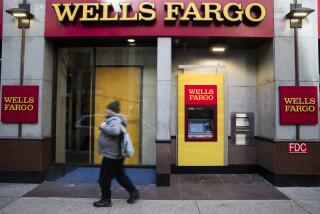Danger, Opportunity Present in Dividends
- Share via
For investors who care about earning cash dividends on their stocks, there are two reasons to look a little closer at those payouts: One, to make sure your dividends aren’t about to disappear with the sinking economy; and two, to check out some tantalizing yields that have resulted from stocks’ slide.
The bad news on dividends is that the weak economy is causing corporate managers to reconsider raising payouts to shareholders this year. Instead, many companies are opting to conserve cash, fearing that profits will continue to slide. Profits, after all, are the source of dividends.
Standard & Poor’s Corp., which tracks dividend moves by thousands of companies nationwide, paints a dreary picture:
* In the first eight months of the year, 904 companies raised their dividends, down 22% from the same period in 1989.
* The trend is rapidly worsening. In August, dividend increases totaled 79, down 33% from August, 1989, the biggest percentage decline yet this year.
* The number of companies cutting or omitting dividends has mushroomed. There were 247 cuts and omissions in the first eight months of this year, up 69% from last year.
The fast rise in cuts and omissions, in particular, is a warning for investors who are tempted to rush blindly into stocks just because they now sport annualized dividend yields of 8% or better. A high yield is the market’s way of signaling that the risk of a cut in the dividend also is high.
“If the economy continues to slow, you’re going to see more of that,” says Tom Broadus, who runs T. Rowe Price Associates’ Equity Income stock mutual fund in Baltimore.
There’s nothing like a bear market to renew investors’ focus on dividends. During bull markets, most investors are so swept away by stocks’ gains that dividends become unimportant in investment decisions.
Now, the amount of cash a company is willing to pay out to shareholders each quarter becomes a crucial source of support for the firm’s stock price. If you know you’re going to earn a 4.5% cash return on a stock over the next year, for example, you might be more inclined to stick with the stock rather than exit now and try to buy back in before the next up move.
And despite the economic gloom, many companies--from retailer Gap Inc. to chocolate king Hershey Foods to oil giant Chevron Corp.--still have felt strong enough lately to boost their dividends substantially, as the accompanying chart shows.
But are those companies whistling in the dark, underestimating the potential severity of a recession and thus their ability to sustain higher dividends? Geraldine Weiss, publisher of La Jolla-based Investment Quality Trends newsletter, doesn’t think so.
Big companies rarely make dividend moves without a lot of thought, Weiss says, because the psychological impact of cutting a dividend later is so devastating. Besides, while the economy appears to be entering a recession, “this certainly isn’t a recession that’s suddenly crept up on us,” she notes. Many companies have been preparing for a slowdown for a long time and have bolstered their finances accordingly.
Still, the surge in dividend cuts and omissions already this year tells you there’s a big overhang of companies that are in weak financial shape--often as a result of the debt excesses of the 1980s. Any investor who cares about dividends ought to be going over his or her stock portfolio, checking to make sure that every company in it is capable of paying the current dividend or, better, increasing it--even in a recession.
One simple test is to look at the “payout ratio”--annual dividend per share as a percentage of annual earnings per share. The average company in the S&P; 500 stock index is paying an annual dividend that represents 57% of earnings over the past four quarters.
Compare your stock’s dividend to recent earnings and projected earnings, and look at the current payout ratio versus the stock’s historical norm. The higher the payout ratio, the lower the dividend’s margin of safety.
Concern about future dividends shouldn’t be limited to industrial or service companies, notes Donna Hostetler, research chief at the brokerage Crowell, Weedon & Co. in Los Angeles. For example, electric utilities long were known for paying high dividends and increasing them at a dependable pace, making them favorites with yield-seeking investors. But “the electric utility business isn’t what it was years ago,” Hostetler warns, owing to many utilities’ diversification into riskier new businesses.
The lesson, says Hostetler, is, “Don’t just chase high yields in any industry, but especially don’t in utilities.” Her firm is recommending such utilities as Pacificorp (dividend yield: 7.2%) and Portland General (7.4%) for investors who want to be confident about dividend growth.
T. Rowe Price’s Broadus sees opportunities in many stocks that are carrying dividend yields higher than their normal yields of the last five years, yet don’t represent high risks in terms of possible bad news, according to his firm’s research. He includes on that opportunity list names such as Texaco (yield: 4.8%), Bristol Myers Squibb (3.4%), Dun & Bradstreet (5%) and IBM (4.7%). In contrast, the S&P; 500 average yield is 3.8%.
Those yields don’t look like much compared to 9% yields on long-term Treasury bonds. But that’s where a lot of investors lose perspective in weighing stocks versus bonds or bank CDs: While a bond or CD interest payment stays the same each year until the investment matures, dividends rise over time. So in the long run, a stock’s dividend can be a major source of return on your original investment.
Example: In 1983, you could have paid $10 a share for Hershey Foods (adjusted for stock splits), when the firm was paying an annual dividend of 37 cents a share. So your yield at the time was just 3.7%--paltry-looking, as is Hershey’s current yield of 2.4%.
But over the past seven years, Hershey has raised the dividend annually, without fail. Now, the yearly dividend is 90 cents a share. If you bought Hershey at $10 a share in 1983, you’re earning a yield of 9% on those shares. And in the meantime, the stock itself has risen, to $37 currently.
Hershey illustrates why the concept of “total return”--stock appreciation and dividends--is so important in choosing stocks. Now more than ever, a company’s dividend history and outlook ought to be a key element of any investor’s game plan.
DIVIDEND OUTLOOK DIMS . . .
Fewer companies are increasing dividends, and more are cutting or omitting them as the economy slows. Data for the first eight months of 1990 versus the same periods in 1988 and 1989:
Dividends raised
1988: 1,156
1989: 1,155
1990: 904
Dividends cut or omitted
1988: 122
1989: 146
1990: 247
Los Angeles Times
. . .BUT NOT FOR THESE FIRMS
Some of the companies that have raised their dividends recently:
New annual Pct. Stock Div. Company dividend hike price yield Gap Inc. $1.00 +32% $54 3/8 1.8% Wal-Mart 0.14 +27% 28 3/4 0.5% Philip Morris 1.72 +25% 45 1/8 3.8% Hershey Foods 0.90 +15% 37 2.4% KN Energy 1.12 +12% 24 4.7% Natl. Med. Ent. 0.80 +11% 35 1/4 2.3% Chevron 3.10 +11% 75 7/8 4.1% Eaton 2.20 +10% 50 7/8 4.3% Union Bank 1.40 +6% 20 7.0%
Los Angeles Times
More to Read
Inside the business of entertainment
The Wide Shot brings you news, analysis and insights on everything from streaming wars to production — and what it all means for the future.
You may occasionally receive promotional content from the Los Angeles Times.










